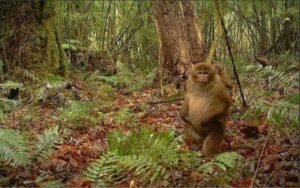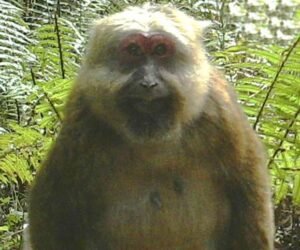By Deshdeep S
Itanagar (Arunachal Pradesh), Feb 19 : They were looking for Red Panda but stumbled upon the white-cheeked macaque, the latest among the 23 macaque species on the earth .A group of scientists the Zoological Survey of India were excited after their “newest mammal” species in the country — the White Cheeked Macaque (Macaca leucogenys).Though it was first discovered in China in 2015, its existence was unknown in India before this. The India researchers found the mammal barely 197 kms away from China, in the remote Anjaw district in central Arunachal Pradesh. The discovery has been published in the Feb 3 issue of international journal ‘Animal Gene’.
Accidental Discovery

Long white whiskers extended from the cheeks and chin gives the new monkey its name- the White Cheeked Macaque. The American Journal of Primatology explains their physical features as “Relative hairless short tail, prominent pale to white side- and chin-whiskers creating a white cheek and round facial appearance, dark facial skin on the muzzle, long and thick hairs on its neck, and a round rather than arrow-shaped male genitalia” . Their whiskers start growing as they reach adulthood, and their facial skin darkens, scientists explain. The white cheeked macaque was discovered while researchers were exploring Himalayan species. “The discovery was entirely accidental. We were not looking for the White Cheeked Macaque ; we had received a grant of Rs 10 crore for a project to study Himalayan species — this involved exploring biodiversity of the Himalayas and studying large threatened species in the region,” ZSI scientist Dr Mukesh Thakur, also the lead author of the study carried out under recently retired director of ZSI, Dr Kailash Chandra, has been quoted in Indian Express . “We conducted surveys in the West Siang, Arunachal Pradesh, India and collected five faeces and two skin samples of macaques that on DNA analysis identified as white cheeked macaques. Subsequently, we undertook intensive field surveys and successfully captured white cheeked macaques in camera traps as well as found a captive juvenile individual during questionnaires from the same region,” Indian researchers said in ‘Animal Gene’, an international journal .
True to their genus (Macaca), white-cheeked macaques are robust and heavy-bodied monkeys. The two most recently described macaque species; the white-cheeked macaque and Arunachal macaque (Macacamunzala) were discovered from a single biodiversity hot spot, the Eastern Himalaya. The Chinese scientists in 2015 fond White Cheeked Macaque from Me dog County, located in the southeast of the Tibet Autonomous Region.
Poaching and Hydro power Stations Are Huge Threat

A lot is required to be researched about this newest mammal. Given the dearth of information about the species, the International Union for Conservation of Nature (IUCN) has not yet assessed their population numbers or the threats to those populations. They have been put under the category of “Not Evaluated”, usually applies to recently described species, like the white-cheeked macaque. But this categorization does not mean that these whiskered monkeys are safe. Without extensive study, white-cheeked macaques are not afforded the protections that better-studied species garner. We could lose these monkeys before we even know enough about them to save them, scientists have apprehended.
Chinese scientists have already explained threats faced by the fascinating monkeys. Humans are the biggest threat . “Though the threats are yet to be evaluated, Illegal poaching by local tribes and habitat loss due to the construction of hydropower stations in Medog are threatening the lives of these monkeys. Of these two threats, the hydropower stations are the more ominous”, they warn in American Journal of Primatology . They also fear that extensive tracts of river front forest (white-cheeked macaque habitat) will be flooded and lost forever; new roads will lead to an influx in the human population and in human settlements—and lead to an increase in the bushmeat trade by providing hunters with easier access to the macaques. “Even the chief engineer for the geological survey team associated with the project has warned, Tibet’s ecology is extremely vulnerable, and would be very hard to restore if damaged”, New England Primate Conservancy reports.
Alarm Call for Conservation

Wildlife researchers also recognize the discovery of the white-cheeked macaque as an alarm call for the conservation of the species, along with the conservation and protection of other species (those already discovered and yet to be discovered) in this bio-diverse region. They urge additional wildlife surveys and studies and call for environmental protection in southeastern Tibet .
Arunachal Pradesh—known as the “land of dawn-lit mountains” and home to white-cheeked-macaques—is situated at the junction of the Eastern Himalayas and Indo-Burma regions. Discovery of this new primate species further highlights the high value for biodiversity conservation of southeastern Tibet and calls for more intensive surveys, studies, and environmental protection in this area”. As many as 169 hydropower projects are also proposed to be built in Arunachal Pradesh. However, it is not known whether any of them would affect the habitat of the white cheeked macaque.
Include the New Mammal In Wildlife Protection Act

The India researchers – Avijit Ghosh,Supriyo Dalui,Tanoy Mukherjee ,Bheem Dutt Joshi, Sujeet Kumar Singh, Gopinathan Maheswaran,Lalit Kumar Sharma ,Kailash Chandra and Mukesh Thakur – involved in the significant research have said that “ Unfortunately,white-cheeked macaque has not been yet included in the Wildlife (Protection)Act, 1972 of India and therefore, the present study laid foundation to promote field studies in Central Arunachal Pradesh to delineate distribution boundary and population size of white-cheeked macaque in Arunachal Pradesh”. They wrote in the February 3 issue of international journal ‘Animal Gene’, “We also demonstrate the first evidence of possible extended distribution of white-cheeked macaque covering an area of about 23,063 sq km.” A white-cheeked macaque geographic range map is not yet available. The latest discovery takes India’s mammal count from 437 to 438.
Image credit :New England Primate Conservancy / Dibyendu Ash/Creative Commons







































